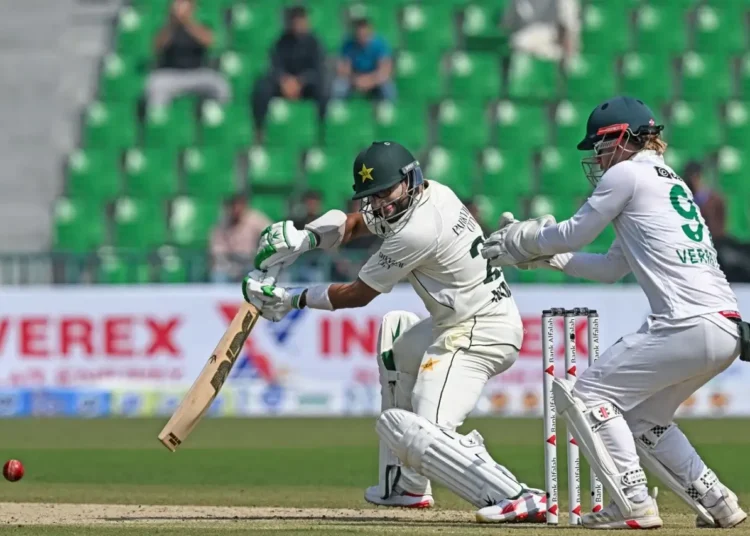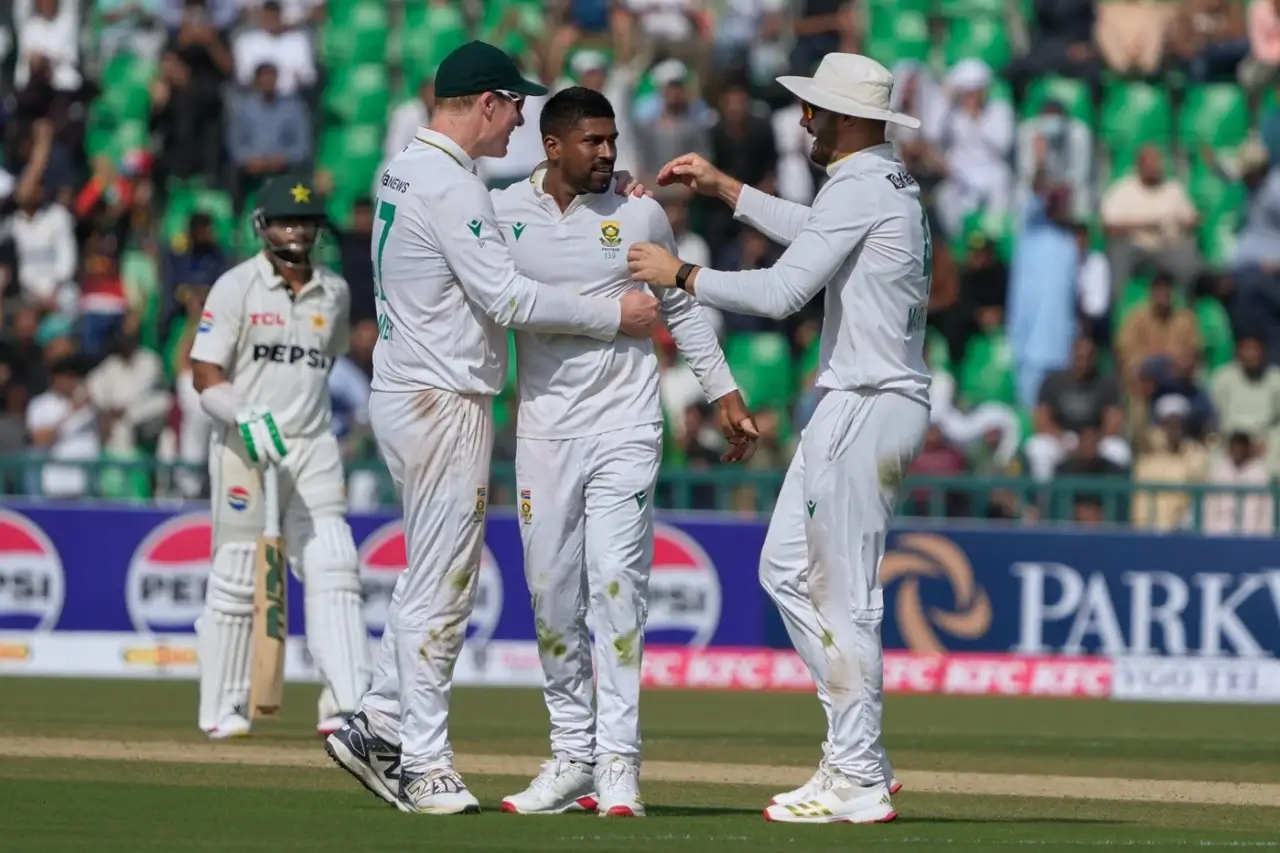Pakistan started its Test campaign in Lahore with steady control and intent. Imam-ul-Haq and Shan Masood stitched a 161-run partnership that set the tone. Both batters combined patience with attacking precision against South Africa’s mixed attack. Imam fell short of a hundred, but his innings gave Pakistan stability early.
As the pitch showed early signs of turn, runs gained higher value. South Africa relied on spin through Muthusamy, Harmer, and Subrayen, who bowled 74 overs combined. They took four wickets but missed key opportunities through dropped catches. Those errors allowed Pakistan’s middle order to recover and dominate the evening.
Mohammad Rizwan and Salman Agha then led Pakistan’s fightback with style. Their unbeaten 114-run stand took Pakistan to 313 for 5 by stumps. The surface looked dry, and cracks had already begun to open slightly. Day two promises to be decisive as spin begins to play a stronger role.
Imam and Masood Build the Foundation With Patience and Precision
Pakistan lost Abdullah Shafique early to Rabada’s sharp swing and pace. But Imam and Masood quickly settled and started rotating strikes with intent. The Imam punished anything full or wide, using wrists to maneuver the gaps. Masood counterattacked, hitting Subrayen for a clean six straight down the ground.
The partnership grew steadily as both handled spin with composure. Imam reached his fifty from just 65 balls, adjusting late and playing soft hands. Harmer extracted some bounce, but Imam’s technique held firm throughout the session. Pakistan ended the first session in full control at 107 for 1.
Masood’s half-century came through a classy drive past mid-on after lunch. He used the crease well to counter Muthusamy’s subtle drift and dip. South Africa created chances, but their fielders dropped Masood and Imam in quick succession. Those missed catches shifted the momentum entirely in Pakistan’s favor for the next hour.
Subrayen eventually broke through, trapping Masood lbw with a straight delivery. Soon after, Muthusamy dismissed Imam for 93, ending a well-paced innings. Still, the 161-run stand had already built a strong platform. Pakistan’s top order had given the home side a crucial first-innings base on a turning pitch.
Rizwan and Agha Lead Late Resistance With Calm and Class
After losing wickets in quick succession, Pakistan’s lower order showed impressive composure. Rizwan took control of the innings, playing positive yet calculated cricket. He used the sweep shot effectively to upset the spinners’ rhythm. Salman Agha supported him with a calm, patient approach at the other end.
Rizwan mixed aggression with touch, cutting and sweeping Harmer confidently. His lofted six over long-on and reverse sweeps added pressure on the bowlers. Agha, who started cautiously, reached fifty with clever strike rotation and timing. Together, they rebuilt Pakistan’s innings with intelligent shot selection and strong communication.
The pair’s partnership grew past a hundred as South Africa lost energy late. Rizwan ended the day unbeaten on 62, controlling the tempo beautifully. Agha’s 52 not out offered support and structure through testing conditions. Their stand not only repaired the innings but also tilted the momentum Pakistan’s way.
By stumps, Pakistan had weathered spin and fatigue to post 313 for 5. The partnership proved vital as bowlers began to lose control under fading light. It was a display of Test-match awareness and batting maturity in demanding conditions.
South Africa’s Spinners Create Chances but Miss Key Opportunities
South Africa went into the Test with three specialist spinners for Lahore’s conditions. Muthusamy, Harmer, and Subrayen bowled tirelessly but lacked crucial breakthroughs. They took four wickets for 248 runs but were hampered by poor fielding. At least four catches went down, each changing the game’s direction.
Muthusamy picked two wickets and created several close chances through flight. Harmer bowled with control and turn but often found no support in the field. Subrayen showed promise, dismissing Masood lbw and challenging both edges regularly. However, Pakistan capitalized on loose fielding and poor catching from the visitors.
Rabada’s early spell provided the only seam threat, removing Shafique quickly. Beyond that, Pakistan’s batters were able to settle and score comfortably. As the ball aged, South Africa’s bowlers struggled to extract movement or bounce. Their overreliance on spin worked against them on a flattening surface.
The trio did find some turn late in the day, suggesting future grip. But without breakthroughs, Pakistan’s partnerships turned dominant as fatigue crept in. South Africa’s sloppy fielding turned early control into late frustration and regret.
Babar’s Short Stay and Lahore Crowd’s Changing Pulse
Babar Azam entered to thunderous cheers as Masood walked off. His short but stylish stay reflected both promise and pressure. He played crisp drives early, racing to 21 off 22 balls. But when spin deepened, his rhythm stalled under Harmer’s consistent line and dip.
Harmer’s turn and bounce trapped Babar lbw on review, ending the excitement. It was a big wicket for South Africa, silencing the Lahore crowd briefly. Babar’s dismissal came as Pakistan lost three wickets without adding a run. Yet, Rizwan and Agha’s calm recovery later softened that blow.
For fans, Babar’s short stay reminded them of Pakistan’s collective strength. Imam, Masood, Rizwan, and Agha ensured the focus wasn’t on one name. The Lahore crowd, initially there for Babar, applauded the team’s depth instead. It was a sign of how Pakistan’s Test side has matured beyond individual brilliance.
Turning Point: Missed Chances and Momentum Shift Toward Pakistan
South Africa’s day was undone by missed opportunities at critical moments. Masood was dropped early, and Imam survived a similar chance later. Muthusamy could have had three wickets before tea if catches stuck. Harmer also saw Rizwan’s edge drop short at slip in the last session.
Each missed chance drained energy and belief from South Africa’s attack. Rizwan capitalized, sweeping Harmer and Muthusamy for quick runs late on. Agha remained solid, ensuring the scoreboard kept ticking safely. Together, they batted the visitors out of contention for the day’s final hour.
Pakistan’s 313 for 5 looked far better than it could have been. The late recovery frustrated South Africa and gave Pakistan full command. If the surface breaks further, the runs will carry added importance. Day two will decide whether this start converts into total dominance.







